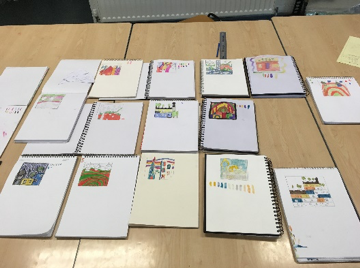To begin the learning of how to use watercolour paints the students completed a sample image in their sketchbooks. The instructions were to replicate an area of the Hundertwasser paintings and colour match them with watercolour. The instruction to match the colours from the original work was not stressed enough and was lost to some pupils. I introduced testing colours in swatches on the page, this was demonstrated by the more able students in the classroom. This skill of watercolour was then applied to the 3D experimentation piece. A challenge of this task was using an appropriate amount of water while producing a strong colour similar to Hundertwasser’s work.

 Use of colour swatches neatly presented under the work. Clear testing of colour and adjustments before adding into sample square.
Use of colour swatches neatly presented under the work. Clear testing of colour and adjustments before adding into sample square.

Matching colours from the Hundertwasser paintings. For future lessons students could include the actual image they are working from to show what the work is in their sketchbooks.
 Lovely use of watercolour, clear understanding of how to manage the material. Clear lines in drawing helped to achieve a concise sample image.
Lovely use of watercolour, clear understanding of how to manage the material. Clear lines in drawing helped to achieve a concise sample image.
 Well drawn design from inspiration. Demonstration of concentration in neat watercolour painting. Achieved a bright colour with the watercolours which is appropriate for the subject matter.
Well drawn design from inspiration. Demonstration of concentration in neat watercolour painting. Achieved a bright colour with the watercolours which is appropriate for the subject matter.



You must be logged in to post a comment.